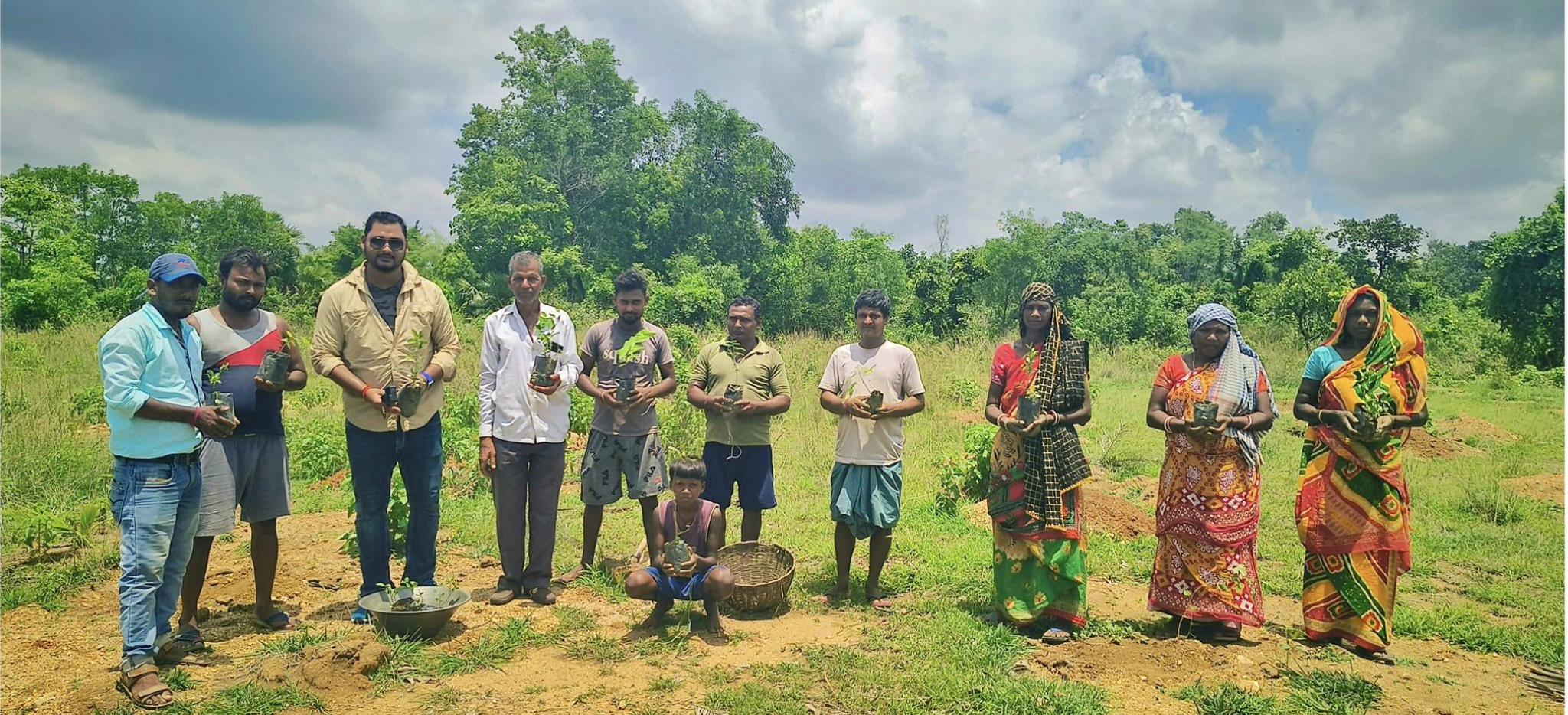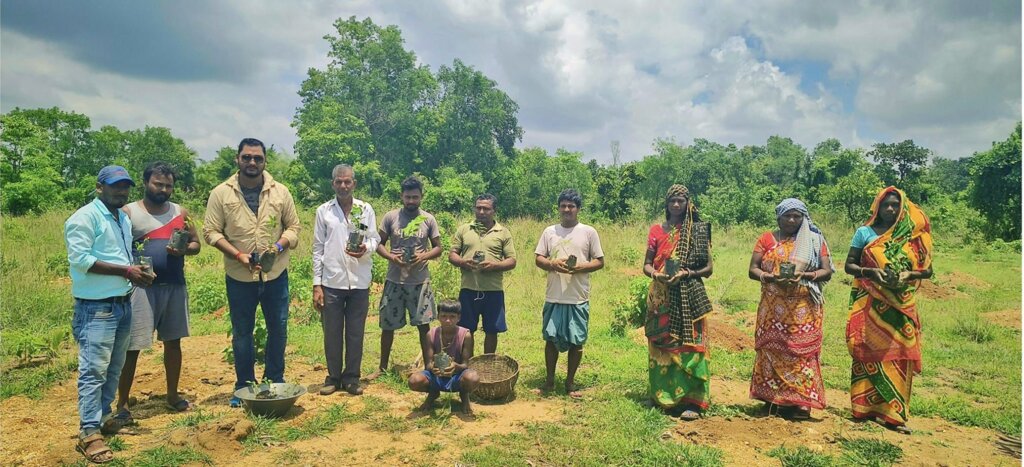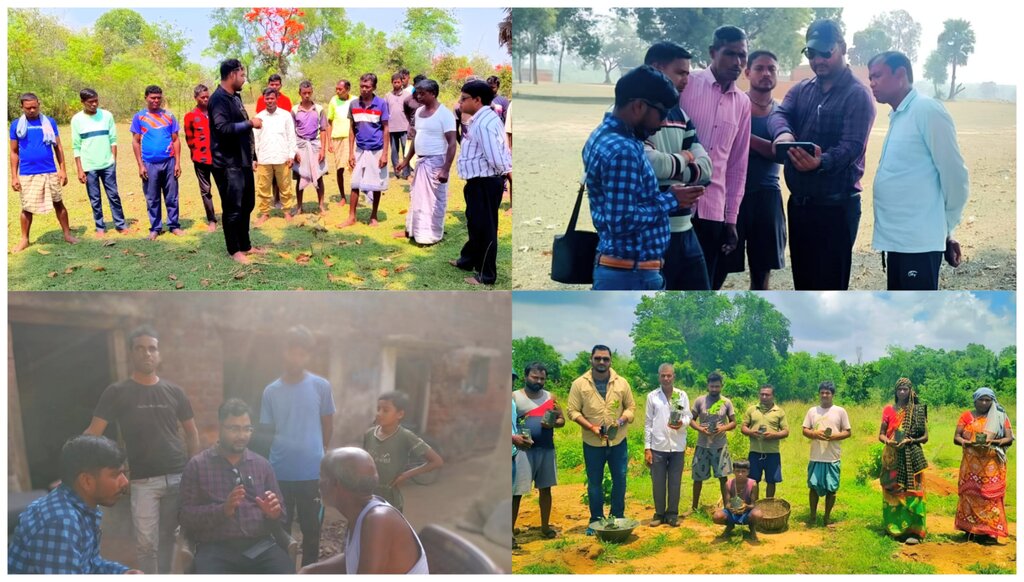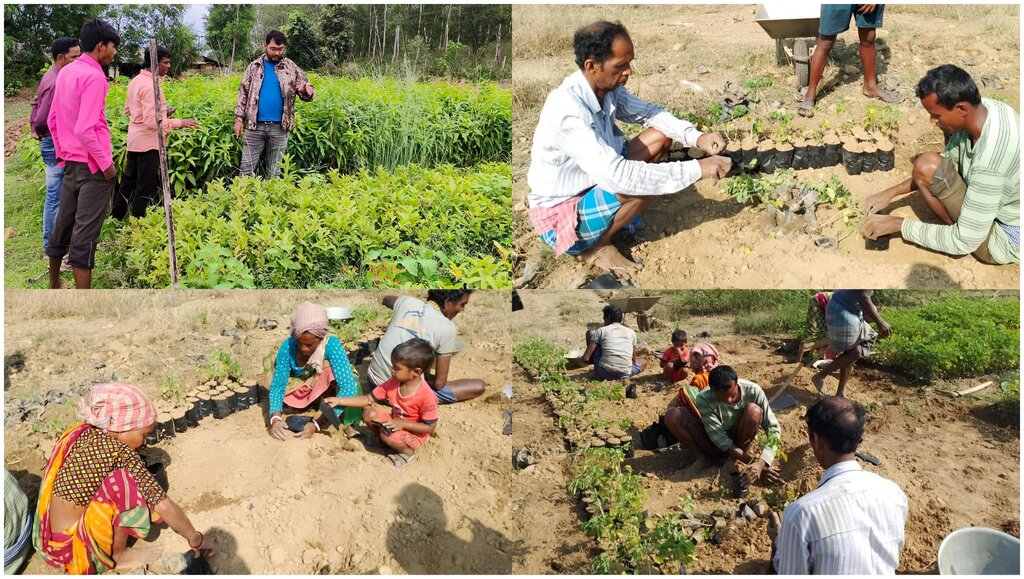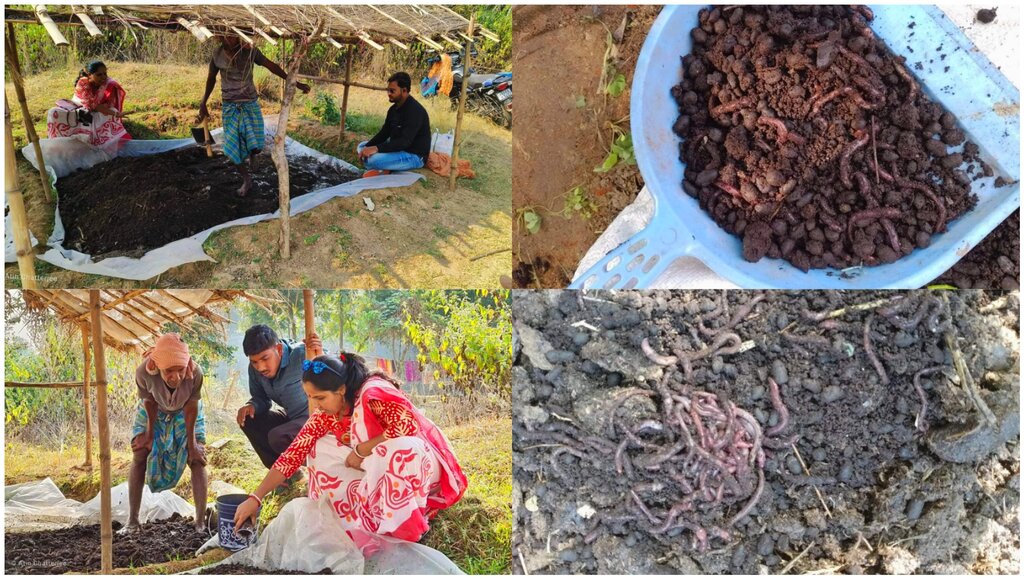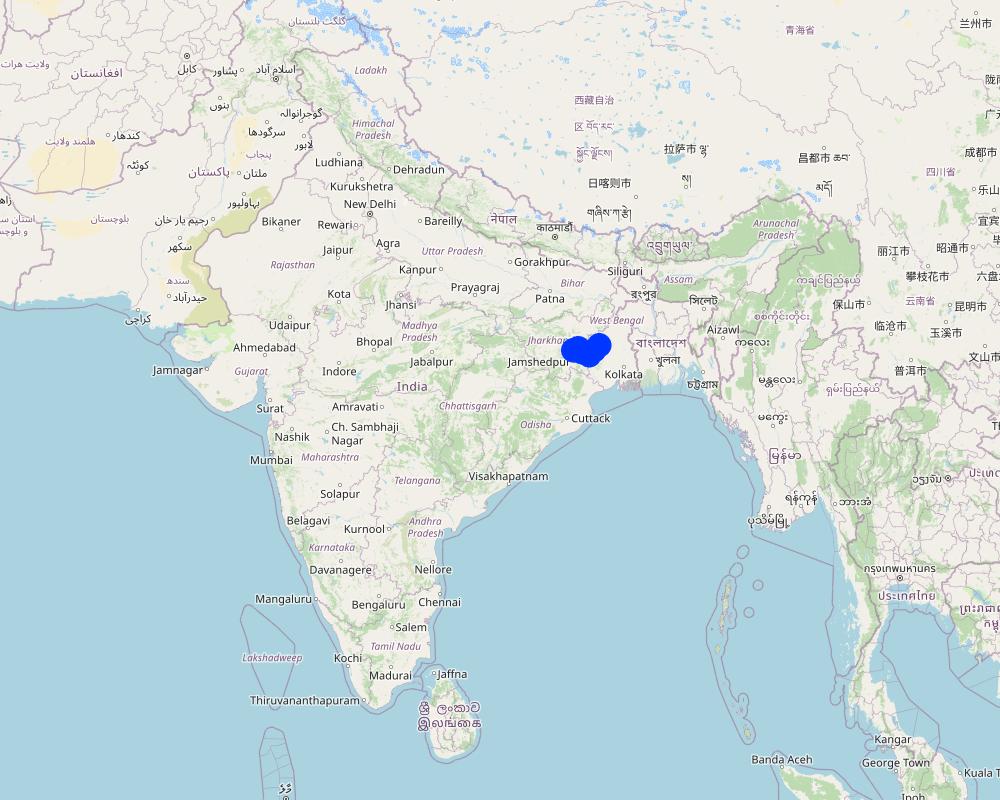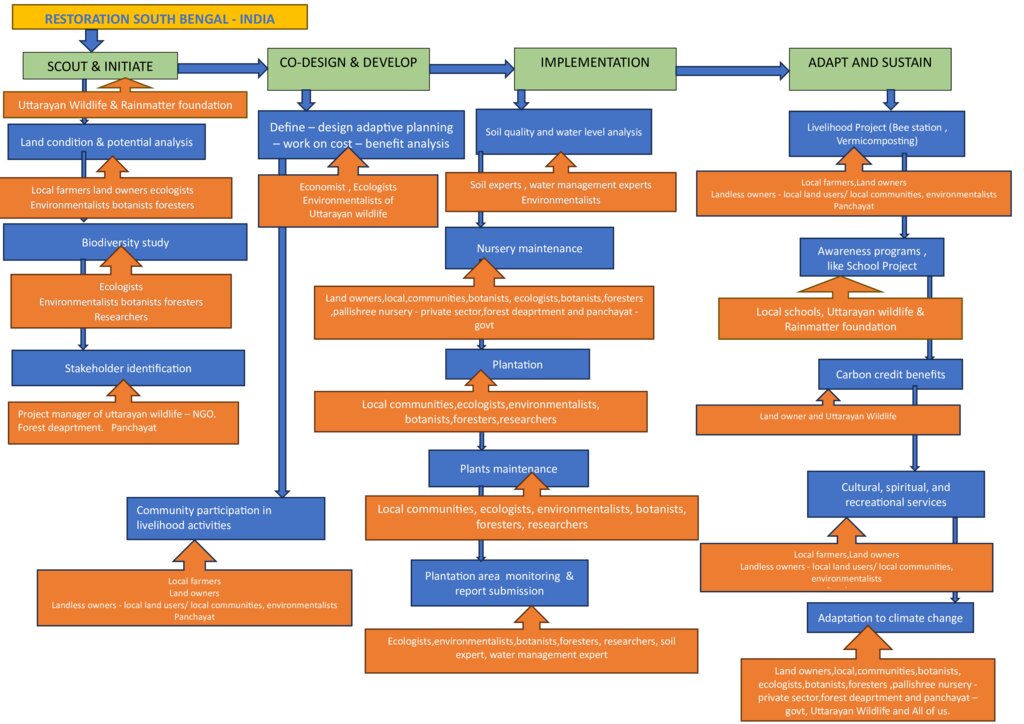Community-led participatory and self sustainable land restoration in India [الهند]
- تاريخ الإنشاء:
- تحديث:
- جامع المعلومات: DIYA BANERJEE
- المحرر: –
- المراجعون: Nicole Harari, William Critchley, Rima Mekdaschi Studer
UW - RM Restoration
approaches_7117 - الهند
عرض الأقسام
توسيع الكل طي الكل1. معلومات عامة
1.2 تفاصيل الاتصال بالأشخاص الرئيسيين لمصدر المعلومات والمؤسسات المعنية بتقييم وتوثيق النهج
اسم المشروع الذي سهّل توثيق/تقييم النهج (إذا كان ذلك على صلة)
Community led participatory and self sustaining degraded land restoration in West Bengal (UW - RM)اسم المؤسسة (المؤسسات) التي سهلت توثيق/تقييم النهج (إذا كان ذلك على صلة)
Uttarayan Wildlife (UW) - الهند1.3 الشروط المتعلقة باستخدام البيانات الموثقة من خلال WOCAT
متى تم تجميع البيانات (ميدانيا)؟:
16/11/2021
يوافق جامع المعلومات والشخص (لاشخاص) الرئيسي لمصدر المعلومات على الشروط المتعلقة باستخدام البيانات الموثقة من خلال WOCAT:
نعم
1.4 المراجع الخاصة باستبيان(استبيانات) تقنيات الإدارة المستدامة للأراضي
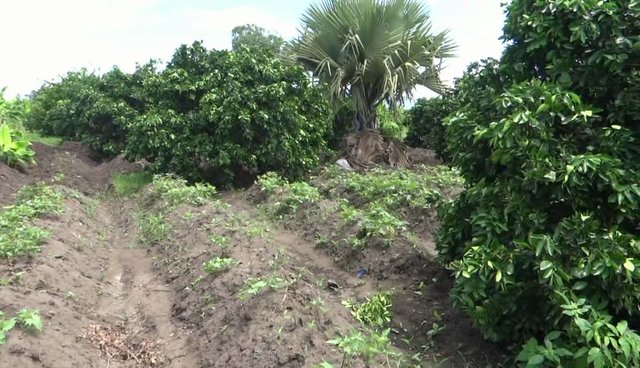
Fruit tree growing for restoration of degraded lands [اوغندا]
Fruit trees of Mangoes (Mangifera indica) and Oranges (Citrus sinensis) are grown on degraded land to improve soil fertility through deep soil nutrient mining and litter of leaves.
- جامع المعلومات: Kamugisha Rick Nelson
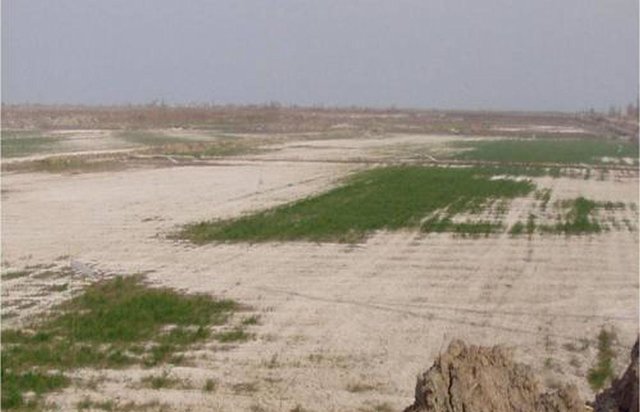
Агролесная мелиорация для реабилитации деградированных орошаемых земель (ИСЦАУЗР) [أوزبكستان]
На участке пахотной земли, не используемой из-за сильного засоления и заболачивания, создается плантация из солеустойчивых древесных пород, преимущественно с азотофиксирующей и высокой биодренажной способностью
- جامع المعلومات: Rustam Ibragimov
2. وصف نهج الإدارة المستدامة للأراضي
2.1 وصف موجز للنهج
A community-led participatory approach is being implemented in West Bengal to revive and regenerate a broken and degraded landscape through sustainable land management. Local people take the lead in both action and the development of a long-term management plan.
2.2 وصف تفصيلي للنهج
وصف تفصيلي للنهج:
Much too long and not written as text. I have summarised and edited the language. One omission was any mention of who “we” are. I have said Uttarayan Wildlife. Is this correct? Please check that and my other edits in the following which I have entered online.
A community-led participatory approach is being implemented in West Bengal to revive and regenerate a broken and degraded landscape through sustainable land management. The approach is facilitated by Uttarayan Wildlife, an NGO. Local people take the lead in both action and the development of a long-term management plan. The identified potential/objective is sustainable and integrated business-driven landscape restoration through community participation. It is hoped to enable local communities to become part of a new generation of business professionals that will take part in integrated landscape management and business-driven landscape restoration.
The direct and indirect stakeholders involved are:
1. Local farmers, and local communities;
2. Local schools and colleges; and
3. Local government authorities
A group of facilitators guide communities in the process of recovery of damaged ecosystems. We try to guide the improvement of land towards its full potential which in our case is a traditional natural forest called Sutan – Bankura – South Bengal. It’s an approach to address a systematic crisis.
The overall goal is to achieve land degradation neutrality (LDN). With landscape restoration, that's more than just the recovery of land because a landscape is also a community. People can revitalize an area, and an economy that restores and uses the landscape with sustainable business.
We work in natural and combined zones in a mosaic restoration pattern and follow basic steps through multi-stakeholder partnerships. The sequence is as follows:
Scout and Initiate:
1. Land condition and potential – analysis and recommendations
2. Biodiversity and native forest reference studies
3. Stakeholder identification and dialogue
Co-design and co-develop:
4. Define and design adaptive planning, work on cost–benefit analyses for transformative change with TEK AND LEK and scientific study strategies/drivers for integrated landscape restoration
5.Develop an ecosystem with all possible community participation in livelihood activities
Implementation:
6. Work on:
a. Soil and water depletion
b. Seeding and plantation through nature-based solutions
c. Unsustainable grazing practices
d. Maintenance
e. Monitoring and evaluation for early learning and to adapt a theory of change
Adapt and Sustain:
7. Link livelihood activities with ecological benefits so that the community starts keeping financial capital/business in mind – and create a business case
8. A period of 20 years is minimum to see all the ‘returns’ which can be added with carbon credit benefits to make it permanent.
9. Cultural, spiritual, and recreational services
10. Adaptation to climate change
Scaling up and replication is the ultimate objective – and we will hand-over to the local community using “exit policies”, allowing entrepreneurs/farmers to develop the right skills and knowledge to independently run successful restoration businesses. We hope to scale this model beyond state boundaries with similar issues and potentials. Throughout, we will practice a public – private - partnership (PPP) to strike the right collaborations and partnerships for an efficient Business Model Canvas in order to achieve successful sustainable ecosystem restoration with the community.
In the initial stage local stakeholders were very wary in terms of trust and faith since they were voluntarily pledging their land, time and resources. With time as the model was tested successfully there has been participation from all quarters.
2.3 صور عن النهج
ملاحظات عامة بخصوص الصور:
Since most efforts are community participatory-led, this gives the local sense of ownership and sustenance making it long term sustainable.
2.4 فيديوهات عن النهج
تعليقات، وصف موجز:
https://www.youtube.com/watch?v=MASkUcKPcUU&t=89s&ab_channel=UttarayanWildlife
Our last two years of activities in a snapshot!
التاريخ:
01/11/2023
الموقع:
Ranibund , Gorshika, Jhilimili, Dhatala, Kechonda, Ayodhya. Bankura and Purulia
اسم مصور الفيديو:
Atin Chatterjee
تعليقات، وصف موجز:
https://www.youtube.com/watch?v=hZri4LpAYOQ&ab_channel=UttarayanWildlife
This is a Before and After Plantation feedback from the local farmers!
التاريخ:
13/12/2023
الموقع:
Gorshika - Purulia
اسم مصور الفيديو:
Atin Chatterjee
2.5 البلد/المنطقة/المواقع التي تم تطبيق النهج فيها
البلد:
الهند
المنطقة/الولاية/المحافظة:
West Bengal
مزيد من التفاصيل حول الموقع:
Bankura, Purulia
Map
×2.6 تواريخ بدء وإنهاء تنفيذ النهج
أشر إلى سنة البدء:
2021
سنة الإنهاء (إذا لم يعد النهج مطبقًا):
2027
التعليقات:
Its a 5 year long approach to empower the locals to continue for the next 10-20 years.
2.7 نوع النهج
- قائم على مشروع/برنامج
2.8 الغايات/الأهداف الرئيسية للنهج
Sustainable and Integrated landscape management and business-driven landscape restoration of degraded ecosystems and landscapes with community participation - enable local communities to become part of a new generation of business professionals that will take part in integrated landscape management and business-driven landscape restoration in a long term sustainable way.
2.9 الظروف التي تمكن أو تعيق تنفيذ التقنية/التقنيات المطبقة بموجب النهج
المعايير والقيم الاجتماعية /الثقافية/ الدينية
- تمكين/تمكيني
The in-built social and religious belief of nature being good enables the project to penetrate easily among locals.
- معيق
The traditional practice of paddy cultivation which presently is of very low yield and loss making but the older generation would not like to try the new agroforestry method or multi cropping system which will regenerate the soil increasing cultivation.
توفر/الوصول إلى الموارد والخدمات المالية
- تمكين/تمكيني
Since its in a start-up mode with investment from Corporate Social Responsibility funds(this is a mandate from India government to all companies running business in India), it enables the project to penetrate smoothly.
الإطار المؤسساتي
- تمكين/تمكيني
The ground level institutional setting in villages have helped us to communicate, facilitate and implement since locals understand the long term benefit.
التعاون/التنسيق بين الجهات الفاعلة
- تمكين/تمكيني
The local farmers, landless labours, schools and colleges, local panchayats coordinate to procure degraded land, participate together to form committees and do long term maintenance of their planted lands.
الإطار القانوني (حيازة الأراضي، وحقوق استخدام الأراضي والمياه)
- تمكين/تمكيني
We dont have any formal legal tenure since its a voluntary and participatory mode to procure land from land owners. This enables us to build trust with the locals.
السياسات
- تمكين/تمكيني
We together with locals adhere to basic country level and land level policies.
حوكمة الأراضي (صنع القرار والتنفيذ والإنفاذ)
- تمكين/تمكيني
Land governance is wholly in the hands of the land owners including all aspects of decision-making, implementation and enforcement. We just enable and empower.
المعرفة حول الإدارة المستدامة للأراضي، والوصول إلى الدعم الفني
- تمكين/تمكيني
Most of the ecology knowledge is derived from our local farmers and their deep understanding of land, soil, water and plants. We also have a team of botanists and ecologists who have done extensive biodiversity study for reference. We have consultant scientists on soil, plants, water levels.
الأسواق (لشراء المدخلات وبيع المنتجات) والأسعار
- تمكين/تمكيني
Target markets are the locals or district level or the nearest big town. Most of our livelihood empowerment would be locally used and sold locally too.
- معيق
Transport cost would be the only hindrance with respect to sending local produce in far away markets.
عبء العمل، توفر القوى العاملة
- تمكين/تمكيني
Availability of man power is onus of the local committee which mostly makes the process smoother.
- معيق
There are cultivation seasons, festivals which hinder the process now and then but its not a show stopper.
3. المشاركة وأدوار الأطراف المعنية
3.1 أصحاب المصلحة المعنيون بالنهج وأدوارهم
- مستخدمو الأراضي المحليون/المجتمعات المحلية
Local farmers
Land owners
Landless owners
Equal participation
- متخصصون في الإدارة المستدامة للأراضي / مستشارون زراعيون
Soil experts
Water management experts
Botanists
Ecologists
Planning
Expert mitigation advise
- الباحثون
Environmentalists
Botanists
Foresters
Biodiversity study
Plant health study
New approach
- المعلمون / أطفال المدارس / الطلاب
Teachers
School management
Students
Participate in nature awareness, walks, knowing biodiversity
Plantation drives
- منظمة غير حكومية
Uttarayan Wildlife
Main implementation
- القطاع الخاص
Rainmatter Foundation
Pallishree Nursery
Funding
Expert consultation
- الحكومة المحلية
Forest Department
Panchayat
Data support
Community Support
إذا كان هناك العديد من الأطراف المعنية، قم بالإشارة إلى الوكالة الرائدة:
NGO - Uttarayan Wildlife
3.2 انخراط مستخدمي الأراضي المحليين/المجتمعات المحلية في المراحل المختلفة للنهج
| انخراط مستخدمي الأراضي المحليين/المجتمعات المحلية | حدد من شارك وصف الأنشطة | |
|---|---|---|
| المبادرة/التحفيز | التعبئة الذاتية | Local farmers and committees: Voluntary participation in pledging their degraded lands for the program to revive and restore. UW approached with the plan. Participate in initiating the program and motivating other farmers to join. |
| التخطيط | تفاعلي | Together with our SLM expert team, the locals interact and plan areas of plantation, use and share their traditional knowledge to mark areas of water, soil quality, cattle grazing and accordingly the plantation map is planned. |
| التنفيذ | تفاعلي | To implement the plan the locals/stakeholders involved create local committees to organise labourers, local resources for a smooth implementation. |
| الرصد/التقييم | التعبئة الذاتية | The local committees are responsible for taking care of plants - watering, checking on health and reporting, creating barriers against cattle grazings, fire etc. They implement their own mulching techniques and use organic fertiliser to safe guard plants. Due to local participation the mortality rate of plants have been less than 20% which is global standard. |
| الدعم الخارجي | We harness expertise of biologists, botanists to document the process and inspect time to time. |
3.3 مخطط التدفق (إذا كان متاحًا)
الوصف:
The above flow chart shows the approach/methodology and the various stakeholders involved at each stage
المؤلف:
Diya Sur
3.4 اتخاذ القرار بشأن اختيار تقنية/تقنيات الإدارة المستدامة للأراضي
حدد من الذي قرر اختيار التقنية/التقنيات التي سيتم تنفيذها:
- مستخدمو الأراضي بشكل أساسي، بدعم من متخصصي الإدارة المستدامة للأراضي
اشرح:
Its a joint partnership in deciding and planning the use of technology/methodlogy as per the condition of the land and weather.
حدد على أي أساس تم اتخاذ القرارات:
- تقييم المعرفة الموثقة جيدًا بشأن الإدارة المستدامة للأراضي(اتخاذ القرارات القائمة على الأدلة)
- نتائج البحوث
- خبرة وآراء شخصية(غير موثقة)
4. الدعم الفني وبناء القدرات وإدارة المعرفة
4.1 بناء القدرات/التدريب
هل تم تقديم التدريب لمستخدمي الأراضي / الأطراف المعنيين الآخرين؟:
نعم
حدد من تم تدريبه:
- مستخدمو الأراضي
- موظفون ميدانيون/ مستشارون
إذا كان ذلك على صلة، حدد الجنس والعمر والوضع والعرق وما إلى ذلك.
Local farmers of different age, social status are trained including women. Gender split is 40:60(women and men consecutively)
شكل التدريب:
- في العمل
- من مزارع إلى مزارع
- مناطق العرض
- اجتماعات عامة
المواضيع المغطاة:
1. Program planning and use of technology/methodology
2. Soil testing
3. Biodiversity checking
4. Vermicompost creation
5. Standard operating procedure for plantation maintenance
6. Bee station maintenance
التعليقات:
Locals absorb very well and show enthusiasm and share their traditional experiences.
4.2 خدمة استشارية
هل يملك مستخدمو الأراضي وصولا إلى خدمة استشارية؟:
نعم
حدد ما إذا كانت الخدمة الاستشارية متوفرة:
- في حقول مستخدمي الأراضي
وصف/تعليقات:
Develop SOP as taught by ecology experts for plantation and maintenance of plantation areas and nursery.
Testing soil conditions by soil experts
Biodiversity surveys to check on environmental health of the surroundings with botanists and biologists
Expert foresters help in planning plantation as per land and water conditions
4.3 تعزيز المؤسسات (التطوير التنظيمي)
هل تم إنشاء أو تعزيز مؤسسات من خلال هذا النهج؟:
- نعم، باعتدال
حدد المستوى (المستويات) التي تم فيها تعزيز أو إنشاء المؤسسات:
- محلي
صف المؤسسة والأدوار والمسؤوليات والأعضاء وما إلى ذلك.
Local farmers have set up voluntary committees to participate and implement and maintain degraded land restoration.
حدد نوع الدعم:
- مالي
- بناء القدرات/التدريب
اعط مزيدا من التفاصيل:
Program has financial support from CSR funds - Rainmatter Foundation and local knowledge and expertise support from Pallishree including capacity building. We have external partners for support on biodiversity surveys, bee keeping.
4.4 الرصد والتقييم
هل يشكل الرصد والتقييم جزءا من النهج؟:
نعم
التعليقات:
We have SOP created and checklists for monitoring and management level evaluations. We do periodic inspections with our external experts to check on the health of the program.
إذا كانت الإجابة بنعم، فهل من المقصود استخدام هذه الوثائق للمراقبة والتقييم؟:
نعم
التعليقات:
The SOP and checklists are used for the monitoring and evaluation.
4.5 البحوث
هل كانت البحوث جزءًا من النهج؟:
نعم
حدد المواضيع:
- علم الايكولوجيا
أعط تفاصيل إضافية وأشر إلى من قام بالبحوث:
We did an extensive biodiversity and phenology research which was carried out by our partner organisation with their botanists, ecologists and foresters for one year. The research paper is being published in ecology forums and science journals.
5. التمويل والدعم المادي الخارجي
5.1 الميزانية السنوية لمكون الإدارة المستدامة للأراضي في النهج المذكور
إذا لم تكن الميزانية السنوية الدقيقة معروفة، قم بالإشارة إلى نطاقها:
- 100,000-10,000
التعليقات (على سبيل المثال المصادر الرئيسية للتمويل/الجهات المانحة الرئيسية):
Rainmatter Foundation - Corporate social Responsibility (its a Government of India social mandate to all profit making companies in India to contribute 2% of their net profit to socially responsible programs run by NGO's.
Rainmatter Foundation is a Zerodha(brokerage firm) outfit of CSR.
5.2 الدعم المالي/المادي المقدم لمستخدمي الأراضي
هل حصل مستخدمو الأراضي على دعم مالي/ مادي لتنفيذ التقنية/ التقنيات؟:
نعم
إذا كانت الإجابة بنعم، حدد نوع (أنواع) الدعم والشروط والمزودين:
They received plants, land preparation, fertiliser, materials to start their livelihood like vermicompost from the program funding.
5.3 إعانات لمدخلات محددة (بما في ذلك العمالة)
- غير موجود
إذا كان العمل من قبل مستخدمي الأراضي مدخلاً جوهريًا، فهل كان:
- مدفوع نقدا
التعليقات:
Rates were as per Indian labour laws.
5.4 الائتمان
هل تم توفير ائتمان في إطار نهج أنشطة الإدارة المستدامة للأراضي؟:
كلا
5.5 حوافز أو وسائل أخرى
هل تم استخدام حوافز أو أدوات أخرى لتشجيع تنفيذ تقنيات الإدارة المستدامة للأراضي؟:
كلا
6. تحليل الأثر والتصريحات الختامية
6.1 آثار النهج
هل ساهم النهج في تمكين مستخدمي الأراضي المحليين وتحسين مشاركة الأطراف المعنية؟:
- لا
- نعم، قليلا
- نعم، باعتدال
- نعم، إلى حد كبير
Since its a community driven participatory program, we engage our land and ecologist experts in a dialogue with the locals to identify specify local problems with land degradation and find the most sustainable solution and long term benefits and with our start-up help locals are empowered to implement the solutions in their land in a sustainable way. Such collaborative engagement leads to improved stakeholder participation.
هل مكّن النهج من اتخاذ القرارات المبنية على الأدلة؟:
- لا
- نعم، قليلا
- نعم، باعتدال
- نعم، إلى حد كبير
Local traditional evidence based knowledge pertaining to the specific land coupled with our biodiversity survey of nearby reference native forests by our ecology experts makes it easier to make informed decision of land management based on evidence.
هل ساعد النهج مستخدمي الأراضي على تنفيذ وصيانة تقنيات الإدارة المستدامة للأراضي؟:
- لا
- نعم، قليلا
- نعم، باعتدال
- نعم، إلى حد كبير
As planned and designed by scientific experts and locals specially on forest land management, agroforestry as an approach for degraded land restoration, it was helpful to implement and maintain the SLM technologies since the approach is jointly agreed upon.
هل نجح النهج في تحسين التنسيق والتنفيذ الفعال من حيث التكلفة لأنشطة الإدارة المستدامة للأراضي؟:
- لا
- نعم، قليلا
- نعم، باعتدال
- نعم، إلى حد كبير
Since its a joint management with locals and program experts, coordination is institutionalized and seemless. Due to close coordination, land procurement happens in bigger portions making it cost effective to implement the SLM technologies and manage in long run.
هل أدى النهج إلى تحسين معرفة وقدرات مستخدمي الأراضي على تنفيذ الإدارة المستدامة للأراضي؟:
- لا
- نعم، قليلا
- نعم، باعتدال
- نعم، إلى حد كبير
Most of the SLM technologies are indigenous
هل أدى النهج إلى تحسين معرفة وقدرات الأطراف المعنية الأخرى؟:
- لا
- نعم، قليلا
- نعم، باعتدال
- نعم، إلى حد كبير
The local stakeholders have a fair amount of traditional knowledge of land management, reasons for soil degradation or even climatic changes. Our experts with their scientific knowledge enhanced local knowledge and traditional beliefs with evidence based theories. Our team experts and local stakeholders learn from each other and we have regular learning sessions enhancing the program on field. https://youtu.be/YJxOtm6qh-c?si=IR4M4LzOxINBVO7h
هل ساهم النهج في بناء/تعزيز المؤسسات والتعاون بين الأطراف المعنية؟:
- لا
- نعم، قليلا
- نعم، باعتدال
- نعم، إلى حد كبير
The community led approach built strong local committees who collaborate to plan, design and implement the program together with industry experts from our program team
هل ساهم النهج في التخفيف من حدة الصراعات؟:
- لا
- نعم، قليلا
- نعم، باعتدال
- نعم، إلى حد كبير
In the initial days of the program, we have witnessed many conflicts arising out of jealousy between landowners whose land is being rewilded and landless people resulting in deliberate plant destruction. Later we changed the approach to include landowners and landless people to form committees and help each other to build and implement the approach reducing conflicts. One of our other goal is also to reduce man-elephant conflict by creating natural habitats for elephants to rest and eat fodder rather than raiding crops.
هل ساهم النهج في تمكين الفئات المحرومة اجتماعيا واقتصاديا؟:
- لا
- نعم، قليلا
- نعم، باعتدال
- نعم، إلى حد كبير
The approach is inclusive and doesnt distinguish with landowners or landless people who are largely socially and economically disadvantaged groups and we try to keep a diverse stakeholder base considering minorities, tribals etc.
هل أدى النهج إلى تحسين المساواة بين الجنسين وتمكين النساء والفتيات؟:
- لا
- نعم، قليلا
- نعم، باعتدال
- نعم، إلى حد كبير
Our nursery is mostly women driven and they get employment. We encourage girls from nearby schools to participate in plantation activities.
هل شجع النهج الشباب/الجيل القادم من مستخدمي الأراضي على الانخراط في الإدارة المستدامة للأراضي؟:
- لا
- نعم، قليلا
- نعم، باعتدال
- نعم، إلى حد كبير
Our special mini program under the main Restoration one is to encourage, empower youth/next generation with climate and nature studies, involve them in restoration work in-field and create micro mini ecosystems in their schools for them to nurture. Our goal is to nurture a generation of nature champions who all will carry this movement forward. https://youtu.be/bX4xK6-fnDs?si=ZkwJdV4LmZgq_MUP
هل أدى هذا النهج إلى تحسين الأمن الغذائي / تحسين التغذية؟:
- لا
- نعم، قليلا
- نعم، باعتدال
- نعم، إلى حد كبير
We address SDG 1 and 2 by creating fruit forest as a food bank/security during times of severe draught which are common in arid regions.
هل أدى النهج إلى استخدام طاقة/ مصادر طاقة أكثر استدامة؟:
- لا
- نعم، قليلا
- نعم، باعتدال
- نعم، إلى حد كبير
We use solar energy for all our energy needs specially in nursery.
هل أدى النهج إلى تحسين قدرة مستخدمي الأراضي على التكيف مع التغيرات المناخية/الظواهر المناخية المتطرفة والتخفيف من الكوارث المرتبطة بالمناخ؟:
- لا
- نعم، قليلا
- نعم، باعتدال
- نعم، إلى حد كبير
One of the bigger goal of this program is to work closely with climate refugees( the local farmers) who are facing harsh climatic conditions, less cultivation/yield, economic slowdown leading to them turning into migration laborers to mitigate climatic disasters like draught due to land degradation. The program wholly addresses land degradation neutrality to enhance soil quality, water levels, increased chances of cultivation through agro-forestry thus mitigating climate related disasters.
هل أدى النهج إلى توفير فرص عمل ودخل؟:
- لا
- نعم، قليلا
- نعم، باعتدال
- نعم، إلى حد كبير
The program employs directly and indirectly more than 1200 locals in land preparation, nursery, plantation work boosting local economy.
6.2 المحفز الرئيسي لقيام مستخدمي الأراضي بتنفيذ الإدارة المستدامة للأراضي
- زيادة الإنتاج
Addressing soil degradation, strategic plantation leads to regeneration of health of land and increased fruit and food production
- زيادة الربح (القدرة)، وتحسين نسبة التكلفة إلى العائد
The fruit trees and other economically beneficial trees like bamboo etc increases profitability and cost-benefit ration in the long run
- الحد من تدهور الأراضي
Soil and water reclamation and plantation reduces land degradation
- الحد من مخاطر الكوارث
Soil and water reclamation and plantation reduces land degradation and reduced risk of climatic disasters
- الوعي البيئي
Locals are environment conscious in their own capacity so empowering them helps to strengthen their belief.
- تعزيز المعرفة والمهارات في مجال الإدارة المستدامة للأراضي
Together with their traditional knowledge and skills of land management, expert trainings and advise helps to enhance SLM knowledge and skills.
- تحسينات جماليية
Presently hectares of unused barren land makes the area look bare so the approach will rewild and make the area look greener with revived biodiversity.
- التخفيف من حدة الصراع
Man-man conflict and man-elephant conflict mitigations are few of the outcomes of the approach.
6.3 استدامة أنشطة النهج
هل يمكن لمستخدمي الأراضي المحافظة على استدامة ما تم تنفيذه من خلال النهج (بدون دعم خارجي)؟:
- نعم
إذا كانت الإجابة بنعم، صف كيف:
With an increased cost-benefit ratio in the long term, creation of food bank and increased cultivation due to land degradation neutrality, the locals would be in a better position to carry forward the approach in a sustainable way without any external support. The approach acts as a start-up kit for a better greener future.
6.4 نقاط قوة/مزايا النهج
| نقاط القوة/ المزايا/ الفرص من وجهة نظر مستخدمي الأراضي |
|---|
|
https://youtu.be/hZri4LpAYOQ?si=twd2yJoek0U1n1B6 As told by the local stakeholders, in past 3 years of the approach/program, they have clearly witnessed land regeneration. |
| They are satisfied by the equal opportunity to plan and design and use their traditional knowledge and skills, reduced man-man conflicts since they work in committees and learning new approaches. |
| They are very happy about increased potential of cultivation and local income. |
| نقاط القوة/ المزايا/ الفرص من وجهة نظر جامع المعلومات أو غيره من الاشخاص الرئيسيين لمصدر المعلومات |
|---|
| The approach being community-led, creates a sense of joint land management reducing internal conflicts and working towards a better future. |
| By achieving land degradation neutrality, regeneration boosts local economy impacting as a watershed, better children's education, more strong local policies towards mitigating climatic extreme conditions. |
| What started as a program has now turned into a local community led movement to uplift land degradation and reduce climate disaster and regenerate biodiversity. |
6.5 نقاط الضعف/ العيوب في المنهج وطرق التغلب عليها
| نقاط الضعف/ المساوىء/ المخاطر من وجهة نظر مستخدم الأراضي | كيف يمكن التغلب عليها؟ |
|---|---|
| Natural disasters like widespread fire destroying plantations | Create trenches and fire lines to stop spreading |
| Severe climatic condition like drought which makes it impossible to nurture the plants | Create water trenches and regenerate local water sources |
| نقاط الضعف/ المساوىء/ المخاطر من وجهة نظر جامع المعلومات أو غيره من الاشخاص الرئيسيين لمصدر المعلومات | كيف يمكن التغلب عليها؟ |
|---|---|
| Natural disasters like widespread fire destroying plantations | Create trenches and fire lines to stop spreading |
| Severe climatic condition like drought which makes it impossible to nurture the plants | Create water trenches and regenerate local water sources |
7. المراجع والروابط
7.1 طرق جمع/مصادر المعلومات
- زيارات ميدانية، مسوحات ميدانية
10-12
- مقابلات مع مستخدمي الأراضي
5-6
- مقابلات مع المتخصصين/الخبراء في الإدارة المستدامة للأراضي
3-4
- التجميع من التقارير والوثائق الأخرى الموجودة
2
7.2 المراجع للمنشورات المتاحة
العنوان، المؤلف، السنة، النظام القياسي الدولي لترقيم الكتب ISBN:
NA( will be published soon)
7.3 روابط للمعلومات ذات الصلة المتوفرة على الإنترنت
العنوان/الوصف:
Program/NGO website
عنوان الرابط URL:
www.uttarayanwildlife.org
العنوان/الوصف:
NGO channel
عنوان الرابط URL:
https://www.youtube.com/channel/UC7q6Ii0lVAUvfDYlsKDMGuQ
العنوان/الوصف:
News articles
عنوان الرابط URL:
https://www.thehindu.com/news/national/other-states/elephant-corridors-to-be-restored-in-south-bengal/article38316050.ece
العنوان/الوصف:
News articles
عنوان الرابط URL:
https://timesofindia.indiatimes.com/city/kolkata/5-year-habitat-restoration-plan-for-south-bengal-jumbo-corridors/articleshow/92447156.cms?utm_source=whatsapp&utm_medium=social&utm_campaign=AmpArticleshowicon&fbclid=IwAR3PFI1eoB9eIPgTxftiO_AV7iBDeO2rc-pf-ByvQGlDMfoFauSSCeiS1FU
العنوان/الوصف:
News articles
عنوان الرابط URL:
ttps://www.thehindu.com/news/national/other-states/elephant-corridors-to-be-restored-in-south-bengal/article38316050.ece?homepage=true
الروابط والوحدات المواضيعية
توسيع الكل طي الكلالروابط

Fruit tree growing for restoration of degraded lands [اوغندا]
Fruit trees of Mangoes (Mangifera indica) and Oranges (Citrus sinensis) are grown on degraded land to improve soil fertility through deep soil nutrient mining and litter of leaves.
- جامع المعلومات: Kamugisha Rick Nelson

Агролесная мелиорация для реабилитации деградированных орошаемых земель (ИСЦАУЗР) [أوزبكستان]
На участке пахотной земли, не используемой из-за сильного засоления и заболачивания, создается плантация из солеустойчивых древесных пород, преимущественно с азотофиксирующей и высокой биодренажной способностью
- جامع المعلومات: Rustam Ibragimov
الوحدات المواضيعية
لا يوجد وحدات مواضيعية


